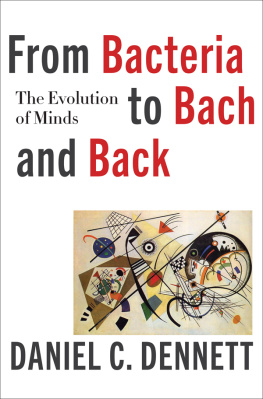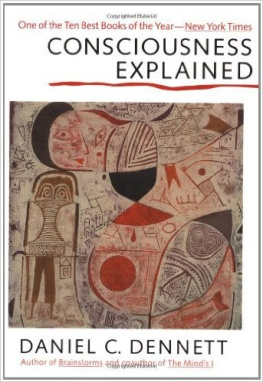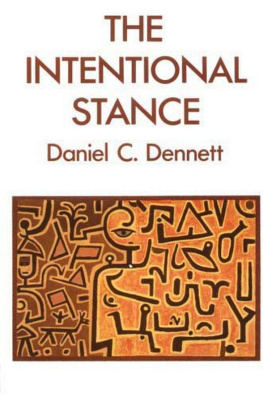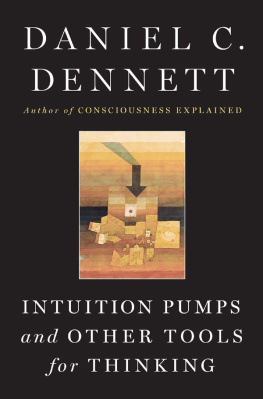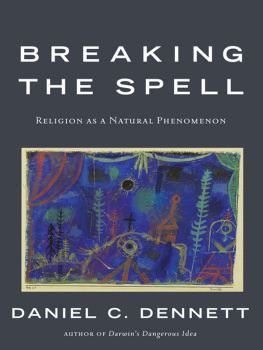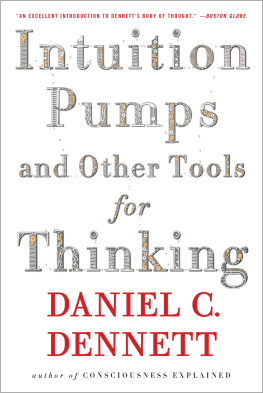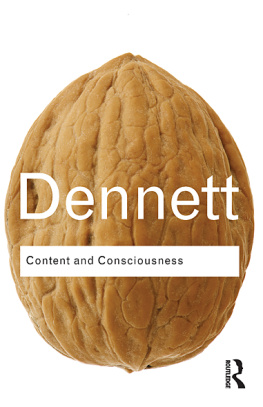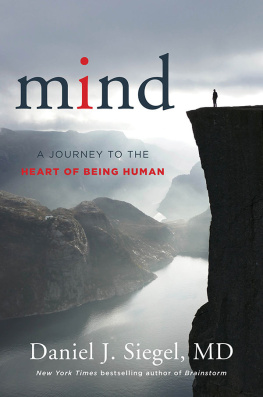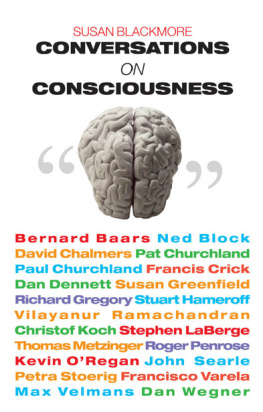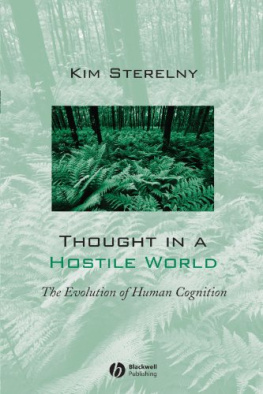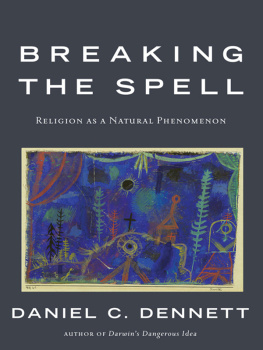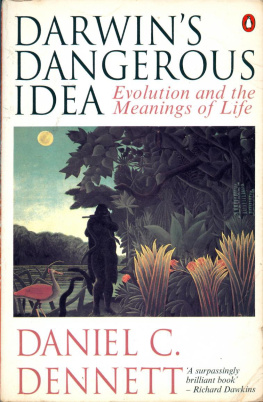
ALSO BY DANIEL C. DENNETT
Caught in the Pulpit (with Linda LaScola)
Intuition Pumps and Other Tools for Thinking
Inside Jokes: Using Humor to Reverse-Engineer the Mind (with Matthew M. Hurley and Reginald B. Adams Jr.)
Science and Religion: Are They Compatible? (with Alvin Plantinga)
Neuroscience and Philosophy: Brain, Mind, and Language (with Maxwell Bennett, Peter Hacker, and John Searle)
Breaking the Spell: Religion as a Natural Phenomenon
Sweet Dreams: Philosophical Obstacles to a Science of Consciousness
Freedom Evolves
Brainchildren: Essays on Designing Minds
Kinds of Minds: Toward an Understanding of Consciousness
Darwins Dangerous Idea: Evolution and the Meanings of Life
Consciousness Explained
The Intentional Stance
Elbow Room: The Varieties of Free Will Worth Wanting
The Minds I: Fantasies and Reflections on Self and Soul (with Douglas R. Hofstadter)
Brainstorms: Philosophical Essays on Mind and Psychology
Content and Consciousness
FROM
BACTERIA
TO BACH AND
BACK
THE EVOLUTION OF MINDS
Daniel C. Dennett

TO BRANDON, SAMUEL, ABIGAIL, AND ARIA
CONTENTS
I started trying to think seriously about the evolution of the human mind when I was a graduate student in philosophy in Oxford in 1963 and knew almost nothing about either evolution or the human mind. In those days philosophers werent expected to know about science, and even the most illustrious philosophers of mind were largely ignorant of work in psychology, neuroanatomy, and neurophysiology (the terms cognitive science and neuroscience would not be coined for more than a decade). The fledgling enterprise dubbed Artificial Intelligence by John McCarthy in 1956 was attracting attention, but few philosophers had ever touched a computer, whirring mysteriously in an air-conditioned prison guarded by technicians. So it was the perfect time for an utterly untrained amateur like me to get an education in all these fields. A philosopher who asked good questions about what they were doing (instead of telling them why, in principle, their projects were impossible) was apparently such a refreshing novelty that a sterling cadre of pioneering researchers took me in, gave me informal tutorials, and sent me alerts about whom to take seriously and what to read, all the while being more forgiving of my nave misunderstandings than they would have been had I been one of their colleagues or graduate students.
Today there are dozens, hundreds, of young philosophers who do have solid interdisciplinary training in cognitive science, neuroscience, and computer science, and they are rightly held to much higher standards than I was. Some of them are my students, and even grandstudents, but other philosophers of my generation jumped into the deep end (often with more training than I) and have their own distinguished flocks of students making progress on the cutting edge, either as interdisciplinary philosophers or as philosophically trained scientists with labs of their own. They are professionals, and I am still an amateur, but by now a well-informed amateur, who gets invited to give lectures and participate in workshops and visit labs all over the world, where I continue my education, having more fun than I ever imagined an academic life could provide.
I consider this book to be, among other things, my grateful attempt to pay my tuition for all that instruction. This is what I think Ive learneda lot of it is still very conjectural, philosophical, out on a limb. I claim that it is the sketch, the backbone, of the best scientific theory to date of how our minds came into existence, how our brains work all their wonders, and, especially, how to think about minds and brains without falling into alluring philosophical traps. That is a controversial claim, of course, and I am eagerly looking forward to engaging with the reactions of both scientists and philosophers, and the amateurs who often have the most perceptive comments of all.
Many have helped me with my books, but I will concentrate here on thanking the people who have specifically helped me with the ideas in this book, and who, of course, are not responsible for the errors that they were unable to talk me out of. These include the participants in the Santa Fe Institute working group I organized on cultural evolution in May of 2014: Sue Blackmore, Rob Boyd, Nicolas Claidire, Joe Henrich, Olivier Morin, Pete Richerson, Peter Godfrey-Smith, Dan Sperber, and Kim Sterelny, as well as others at SFI: especially Chris Wood, Tanmoy Bhattacharya, David Wolpert, Cris Moore, Murray Gell-Mann, and David Krakauer. I would also like to express my gratitude to Louis Godbout of the Sybilla Hesse Foundation, for supporting the workshop.
Then there are my Tufts students and auditors who participated in a seminar in the spring of 2015 that went through most of the chapters in early drafts: Alicia Armijo, Edward Beuchert, David Blass, Michael Dale, Yufei Du, Brendan Fleig-Goldstein, Laura Friedman, Elyssa Harris, Justis Koon, Runeko Lovell, Robert Mathai, Jonathan Moore, Savannah Pearlman, Nikolai Renedo, Tomas Ryan, Hao Wan, Chip Williams, Oliver Yang, and Daniel Cloud, who visited the seminar to discuss his new book. And Joan Vergs-Gifra, Eric Schliesser, Pepa Toribio, and Mario Santos Sousa and the rest of the happy group who gathered at the University of Girona where I spent an intensive week as Guest Lecturer for the Ferrater Mora Chair of Contemporary Thought in May. Another test-bed was provided by Anthony Grayling and the faculty and students he has convened at the New College of the Humanities in London, where I have been trying out versions of these ideas for the last four years.
Others who wrestled with my drafts, changed my mind, noted my errors, and urged me to try for greater clarity include Sue Stafford, Murray Smith, Paul Oppenheim, Dale Peterson, Felipe de Brigard, Bryce Huebner, Enoch Lambert, Amber Ross, Justin Junge, Rosa Cao, Charles Rathkopf, Ronald Planer, Gill Shen, Dillon Bowen, and Shawn Simpson. Further good advice has come from Steve Pinker, Ray Jackendoff, David Haig, Nick Humphrey, Paul Seabright, Matt Ridley, Michael Levin, Jody Azzouni, Maarten Boudry, Krys Dolega, Frances Arnold, and John Sullivan.
As with my previous book, Intuition Pumps and Other Tools for Thinking , editors Drake McFeely and Brendan Curry at Norton challenged me to clarify, simplify, compress, expand, explain, and sometimes expunge, making the finished book a much more unified and effective reading experience than it would have been without their expert advice. John Brockman and Katinka Matson, as always, have been the perfect literary agents, advising, encouraging, entertainingand, of course, sellingthe author at home and abroad. Teresa Salvato, Program Coordinator at the Center for Cognitive Studies, has handled all the logistics of my academic life for years, releasing thousands of prime-time hours for writing and researching, and played a more direct helping role for this book, tracking down books and articles in libraries and organizing the references.
Finally, my wife Susan, who has been my mainstay, advisor, critic, and best friend for more than half a century, has kept just the right amount of heat on the stove to keep the pot happily simmering, through all the ups and downs, and deserves accolades for her contributions to our joint enterprise.
Daniel Dennett
North Andover, MA
March 28, 2016 |
H ow come there are minds? And how is it possible for minds to ask and answer this question? The short answer is that minds evolved and created thinking tools that eventually enabled minds to know how minds evolved, and even to know how these tools enabled them to know what minds are. What thinking tools? The simplest, on which all the others depend in various ways, are spoken words, followed by reading, writing, and arithmetic, followed by navigation and mapmaking, apprenticeship practices, and all the concrete devices for extracting and manipulating information that we have invented: compass, telescope, microscope, camera, computer, the Internet, and so on. These in turn fill our lives with technology and science, permitting us to know many things not known by any other species. We know there are bacteria; dogs dont; dolphins dont; chimpanzees dont. Even bacteria dont know there are bacteria. Our minds are different. It takes thinking tools to understand what bacteria are, and were the only species (so far) endowed with an elaborate kit of thinking tools.
Next page
